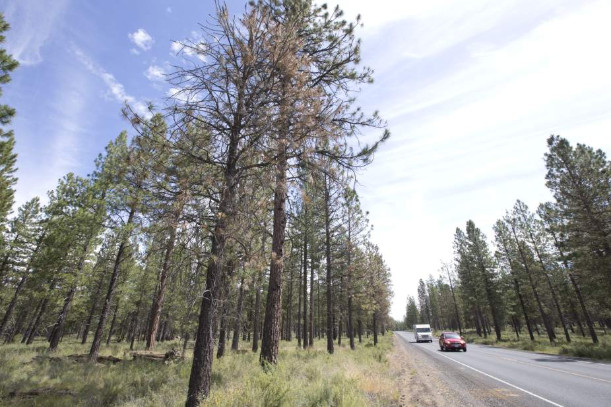A weed-killer responsible for killing thousands of trees outside Sisters has also been linked to dead ponderosa pines near Sunriver — and potentially across Oregon.
The Oregon Department of Agriculture, which monitors pesticides and herbicides in the state, has reached out to the U.S. Environmental Protection Agency about the possibility of widespread impacts to trees due to the main active ingredient in Perspective, the herbicide responsible for killing trees along U.S. Highway 20 near Sisters.
Dale Mitchell, program manager for ODA, said the investigation into the incident outside Sisters revealed several similar cases in Central Oregon, including one outside Sunriver, where dozens of ponderosa pines may have been killed by the same active ingredient.
“We are looking at gathering additional information on this ingredient,” Mitchell said.
In 2013 and 2014, the Deschutes County Road Department sprayed Perspective alongside Cottonwood Road and S. Century Drive, the two main roads in and out of Sunriver. Chris Doty, the county road department director, said roadside spraying is a common practice, designed to reduce the amount of flammable grass in the right of way.
Employees of the county road department and the U.S. Forest Service, which owns the surrounding land, began to notice ponderosa pines with brown and ill-formed needles in the area, and brought in an ODA investigator to investigate further.
As part of the testing process, Mitchell said, investigators take soil and foliage samples to determine if a harmful herbicide is present in the area.
Mitchell couldn’t confirm the results of ODA’s testing, but a subsequent report by the U.S. Forest Service noted dying and browning foliage along Cottonwood Road in 2013, where the herbicide was applied.
Subsequent testing in 2015 revealed the damage had spread, according to the Forest Service report. Only trees adjacent to the road’s right of way appeared to be affected.
Doty said “dozens” of ponderosa pines along Cottonwood and S. Century were affected, though he noted that some dead or damaged trees in the area may be suffering from root damage or other unrelated issues. He added the impact was far smaller than in Sisters, where more than 1,000 ponderosa pines and other trees along a 12-mile stretch of Highway 20 have been killed by repeated use of Perspective between 2013 and 2015.
“In this case, I think the damage is fairly limited,” Doty said.
Still, Sallie Hennessy, a longtime Sunriver resident, noted that dying trees could be a fire risk for the community, in addition to being an eyesore along the community’s two main entrances.
“Sometimes if the sun’s on it, it doesn’t look that bad,” Hennessy said. “But it really is bad.”
Mitchell said it wasn’t until after the agency concluded its investigation of the Sisters incident in 2015 that the agency determined the issue deserved a closer look across Oregon.
The active ingredient in Perspective, aminocyclopyrachlor, has been linked to tree deaths outside of Oregon as well. It was the active ingredient in Imprelis, an herbicide made by DuPont that was linked to the deaths of thousands of spruce and pine trees across the Midwest in 2011, according to The New York Times.
“We do understand that the U.S. EPA has a history with this active ingredient,” Mitchell said.
Elsewhere in Deschutes County, Perspective was used near several roads north of La Pine, including Paulina-East Lake Road. While similar tree effects have been observed in the area, Jean Nelson-Dean, public affairs officer for the Deschutes National Forest, added that subsequent research shows the damage there may have been caused by mountain pine beetles.
Mitchell said the agency is talking with the EPA about strengthening the language on the label for Perspective. Currently, the product’s label cautions against using the product near ponderosa pines, but does not prohibit it outright. The label advises not to use Perspective near the roots of “desirable” trees “unless injury or loss can be tolerated.” The state agriculture department is attempting to learn more about where the product has been used, and has reached out to the EPA about changing the product label to include additional restrictions.
“We’re raising questions about the adequacy of the label,” Mitchell said.
Doty said the county has discontinued its use of Perspective. Still, the question of why the product was used so frequently in Central Oregon is difficult to answer.
Lisa Arkin, executive director at Beyond Toxics, a Eugene-based organization that focuses on threats to environmental and human health, said using chemicals to remove roadside plants is standard practice for a lot of state and local agencies, and many people aren’t aware of the potential impacts.
“People might be negligent, but they might just not know this is an issue,” she said.
Doty said the county road department selected Perspective because roadside weeds can adapt to repeated use of an herbicide, so the county switches up its products after three or four years. He added that Perspective was cheaper than other products on the market.
“Everyone’s always looking for the latest and greatest,” Doty said.
Doty added that the road department is planning to remove the dead trees in Sunriver in the fall and winter. Any standing trees deemed to be a fire risk or a risk to fall on the road will be removed as needed.
“If we felt like it was imminent, we can take them down now,” Doty said.
Credit: www.bendbulletin.com

